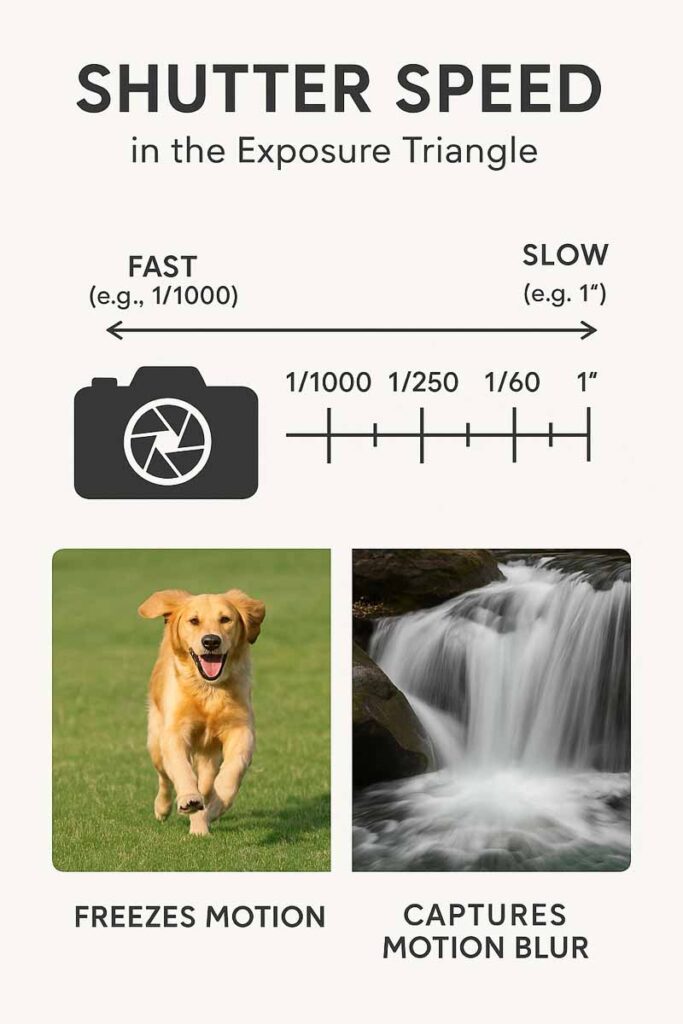Understanding Shutter Speed: Freeze or Blur the Moment
If you’ve ever taken a photo of a fast-moving subject—like your pet mid-jump or a waterfall in full flow—and wondered why it turned out blurry or crystal clear, you’re already asking the right questions about shutter speed.
Shutter speed is one of the three pillars of the Exposure Triangle, along with aperture and ISO. Mastering this setting helps you take control of your photos and tell the story you want to tell. Whether it’s freezing action or showing the smooth motion of a flowing river, shutter speed plays a huge role.
Let’s break it down in a simple, easy-to-understand way.
What is Shutter Speed?
Shutter speed refers to how long your camera’s shutter stays open to expose the sensor to light. It’s measured in fractions of a second—like 1/250 or 1/1000 for fast speeds—and whole seconds for slower ones—like 1″, 2″, or more.
- Fast shutter speeds (e.g., 1/500, 1/1000) freeze action.
- Slow shutter speeds (e.g., 1″, 2″) capture motion blur.
Think of it like opening a window:
- Open it quickly, and only a small gust of air (light) comes in—great for bright scenes or fast-moving subjects.
- Keep it open longer, and you let in more air (light)—ideal for darker scenes or to show motion.
When to Use Fast vs. Slow Shutter Speeds
| Scenario | Suggested Shutter Speed | Result |
|---|---|---|
| Sports or wildlife | 1/1000 or faster | Freezes action |
| Portraits | 1/125 – 1/250 | Keeps subject sharp |
| Low-light without tripod | 1/60 or faster | Avoids camera shake |
| Waterfalls (motion blur) | 1″ or slower | Creates smooth, dreamy effect |
| Night scenes with tripod | 5″ or longer | Captures light trails or stars |
Tip: The slower your shutter speed, the more important it is to use a tripod to avoid camera shake.
How Shutter Speed Affects Exposure
Shutter speed doesn’t just control motion—it also affects how bright or dark your photo is. A faster shutter lets in less light, making the image darker. A slower shutter lets in more light, brightening it up.
That’s why shutter speed works in balance with aperture and ISO in the Exposure Triangle. If you slow down your shutter to let in more light, you might need to narrow your aperture or lower your ISO to avoid overexposure.
Practice Makes Perfect – Join the Beginner Photography Bootcamp!
Understanding the theory is a great first step—but putting it into practice is where the magic happens.
That’s why we’ve designed the Omnilargess Beginner Photography Bootcamp—a hands-on, practical course that walks you through the Exposure Triangle, camera controls, and more. We’ll guide you step-by-step through mastering shutter speed, aperture, and ISO in real-life situations.
Next Bootcamp Starts September 5!
- 4 sessions + 2 outdoor field trips
- Small class sizes for personal attention
- Perfect for new photographers or DSLR/mirrorless camera owners
By the end of the Bootcamp, you won’t just understand shutter speed—you’ll be confidently using it to create the kinds of photos you’ve always dreamed of.
Click here to learn more and register before spots fill up!
Final Thoughts
Shutter speed is your tool for storytelling through motion—whether that means freezing a hummingbird’s wings in flight or showing the dreamy swirl of water over rocks. Once you understand how it works, the creative possibilities are endless.
So grab your camera and start experimenting—or better yet, join us at the next Beginner Photography Bootcampand let us help you bring your vision to life!
Want More Free Photography Tips?
Follow us on Instagram and Facebook for daily photography tips and tutorials.

That is all for now. Stay tuned for my following photography Tips. We love to hear from you. Let us know if you have any questions; feel free to send us your questions, and we will gladly answer them. Follow us on Facebook, Instagram and Twitter for more Free Tutorials and Tips.
Ted and the Omnilargess Team



